MultiFocus Polarization Microscope (MF-PolScope) for 3D polarization imaging of up to 25 focal planes simultaneously
- PMID: 25837112
- PMCID: PMC5802244
- DOI: 10.1364/OE.23.007734
MultiFocus Polarization Microscope (MF-PolScope) for 3D polarization imaging of up to 25 focal planes simultaneously
Abstract
We have developed an imaging system for 3D time-lapse polarization microscopy of living biological samples. Polarization imaging reveals the position, alignment and orientation of submicroscopic features in label-free as well as fluorescently labeled specimens. Optical anisotropies are calculated from a series of images where the sample is illuminated by light of different polarization states. Due to the number of images necessary to collect both multiple polarization states and multiple focal planes, 3D polarization imaging is most often prohibitively slow. Our MF-PolScope system employs multifocus optics to form an instantaneous 3D image of up to 25 simultaneous focal-planes. We describe this optical system and show examples of 3D multi-focus polarization imaging of biological samples, including a protein assembly study in budding yeast cells.
Figures
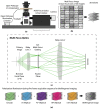


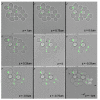









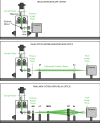
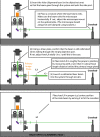

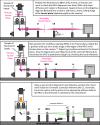
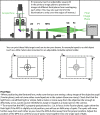
Similar articles
-
Fast multicolor 3D imaging using aberration-corrected multifocus microscopy.Nat Methods. 2013 Jan;10(1):60-3. doi: 10.1038/nmeth.2277. Epub 2012 Dec 9. Nat Methods. 2013. PMID: 23223154 Free PMC article.
-
Whole-cell, multicolor superresolution imaging using volumetric multifocus microscopy.Proc Natl Acad Sci U S A. 2014 Dec 9;111(49):17480-5. doi: 10.1073/pnas.1412396111. Epub 2014 Nov 24. Proc Natl Acad Sci U S A. 2014. PMID: 25422417 Free PMC article.
-
Rapid and quantitative imaging of excitation polarized fluorescence reveals ordered septin dynamics in live yeast.Biophys J. 2011 Aug 17;101(4):985-94. doi: 10.1016/j.bpj.2011.07.008. Biophys J. 2011. PMID: 21843491 Free PMC article.
-
Polarization-resolved Stokes-Mueller imaging: a review of technology and applications.Lasers Med Sci. 2019 Sep;34(7):1283-1293. doi: 10.1007/s10103-019-02752-1. Epub 2019 Mar 4. Lasers Med Sci. 2019. PMID: 30830559 Review.
-
Differential polarization nonlinear optical microscopy with adaptive optics controlled multiplexed beams.Int J Mol Sci. 2013 Sep 9;14(9):18520-34. doi: 10.3390/ijms140918520. Int J Mol Sci. 2013. PMID: 24022688 Free PMC article. Review.
Cited by
-
Multifocus microscopy with precise color multi-phase diffractive optics applied in functional neuronal imaging.Biomed Opt Express. 2016 Feb 16;7(3):855-69. doi: 10.1364/BOE.7.000855. eCollection 2016 Mar 1. Biomed Opt Express. 2016. PMID: 27231594 Free PMC article.
-
Unravelling 3D Dynamics and Hydrodynamics during Incorporation of Dielectric Particles to an Optical Trapping Site.ACS Nano. 2023 Feb 28;17(4):3797-3808. doi: 10.1021/acsnano.2c11753. Epub 2023 Feb 17. ACS Nano. 2023. PMID: 36800201 Free PMC article.
-
Transforming the development and dissemination of cutting-edge microscopy and computation.Nat Methods. 2019 Aug;16(8):667-669. doi: 10.1038/s41592-019-0475-y. Nat Methods. 2019. PMID: 31363203 Free PMC article.
-
Polarization-sensitive intensity diffraction tomography.Light Sci Appl. 2023 May 18;12(1):124. doi: 10.1038/s41377-023-01151-0. Light Sci Appl. 2023. PMID: 37202421 Free PMC article.
-
SPED Light Sheet Microscopy: Fast Mapping of Biological System Structure and Function.Cell. 2015 Dec 17;163(7):1796-806. doi: 10.1016/j.cell.2015.11.061. Cell. 2015. PMID: 26687363 Free PMC article.
References
-
- Oldenbourg R., Mei G., “New polarized light microscope with precision universal compensator,” J. Microsc. 180(2), 140–147 (1995), www.openpolscope.org.10.1111/j.1365-2818.1995.tb03669.x - DOI - PubMed
Publication types
MeSH terms
Substances
Grants and funding
LinkOut - more resources
Full Text Sources
Other Literature Sources
Molecular Biology Databases

